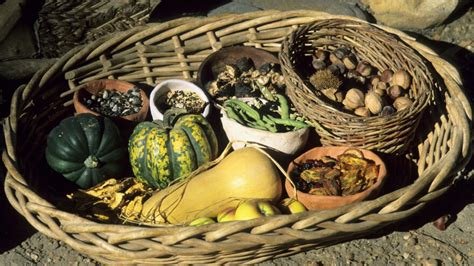Explore the traditional diet of Native Americans, focusing on nutrient-dense foods rich in fats and proteins. Learn how ancient dietary practices contributed to their remarkable health and vitality.
Understanding the Native American Diet: A Historical Perspective
In recent years, the fascination with ancient diets has surged, with many modern health experts touting the benefits of a Paleolithic-style diet. This so-called “Paleo Diet,” inspired by the eating habits of hunter-gatherers, emphasizes high protein and fiber intake from a diverse range of plant foods. Yet, the true essence of this ancient diet is often lost in translation, as contemporary interpretations tend to skew towards low-fat and plant-centric meals.

Jean Carper’s Stone Age Salad might feature greens, beans, chicken breast, walnuts, and a citrus vinaigrette, while Elizabeth Somer’s Stone Age food pyramid includes items like whole wheat waffles and nonfat dairy. However, these modern versions diverge significantly from the authentic diet practiced by Native Americans.
The True Staples of Native American Cuisine
Native American diets were not merely about lean meats and leafy greens; they were rich in animal fats and organ meats, key components of their traditional nutrition. This diet was highly varied, reflecting the diverse environments across North America. Native Americans consumed a wide array of animal proteins, including large game like buffalo, deer, and moose, as well as smaller animals, fish, birds, and even insects.
Dr. Boyd Eaton and Professor Loren Cordain highlight that the diet of these indigenous peoples was high in protein and low in total fat. Yet, this doesn’t quite capture the reality of their intake. Contrary to the low-fat ideals of modern interpretations, traditional Native American diets were actually rich in saturated fats, derived from the animals they hunted.
Health and Vitality: The Evidence
Historical accounts and studies by researchers like Weston Price reveal the impressive health of Native American populations. Price observed remarkable dental health and physical robustness among tribes that adhered to their traditional diets. For instance, Price noted the absence of tooth decay and skeletal deformities in Native American groups living in their traditional ways.

Dr. Romig in Alaska observed that indigenous people who maintained their traditional diets had lower incidences of malignant diseases and surgical issues compared to those who had adopted Western diets. These findings underscore the effectiveness of a diet high in animal fats and organ meats in maintaining health.
The Role of Animal Fats in Traditional Diets
The core of Native American nutrition was the consumption of entire animals. They utilized not just the muscle meat but also the organs and fats. For instance, Beverly Hungry Wolf describes how her grandmother prepared buffalo, using every part of the animal, including its fat, which was rendered and stored for later use.
Animal fats were highly prized and integral to their diet. They understood the value of these fats, which were not only energy-dense but also rich in essential fatty acids. Dr. Eaton’s assertion that wild game fat was predominantly polyunsaturated overlooks the reality that many of the fats from animals like buffalo were highly saturated.
Sacred and Essential Foods
Animal fats were considered sacred and vital for health. Bear fat, for example, was revered for its nutritional and spiritual benefits. It was often consumed during sacred ceremonies and believed to enhance physical strength and fertility.
In addition to fats, other parts of the animal were also utilized in traditional cooking. Samuel Hearne’s descriptions of dishes made from caribou blood, fat, and organs reflect the resourcefulness and deep connection Native Americans had with their food sources.

Modern Misconceptions vs. Traditional Wisdom
The modern interpretation of the Paleolithic diet often excludes the rich, fatty components that were central to Native American nutrition. Contemporary dietary guidelines frequently advocate low-fat diets, which contrasts sharply with the high-fat, nutrient-dense diets of Native Americans.
When Native Americans transitioned from their traditional diets to processed foods, their health significantly declined. Weston Price’s observations highlight the stark contrast between the health of those who adhered to traditional eating patterns and those who adopted modern, processed foods.
Embracing Traditional Nutrition Today
To reclaim the health benefits of traditional Native American diets, consider integrating elements such as high-quality animal fats, organ meats, and fatty fish into your diet. Whole, unprocessed foods—including raw dairy, good fats like butter and lard, and a variety of nutrient-dense plant foods—mirror the traditional practices that contributed to robust health in Native American communities.

Modern dietary approaches should draw from historical wisdom, combining traditional food practices with contemporary knowledge. While fully reverting to ancient diets might not be feasible for everyone, incorporating these elements can lead to improved health outcomes and a deeper appreciation of historical nutrition.
Sidebar: The Impact of Modern Food Policies on Native American Health
Native American Diet and Diabetes: Many Native Americans face significant health challenges, including Type II Diabetes, partly due to the modern food distribution programs that favor high-carbohydrate, low-fat foods. These government policies contribute to health issues by neglecting traditional, nutrient-dense diets. Advocacy for dietary changes and a return to traditional food systems could help mitigate these health problems.
In summary, the traditional diet of Native Americans, rich in fats and diverse animal proteins, provides valuable insights into achieving optimal health. Understanding and appreciating these dietary practices can offer practical guidance for improving modern nutrition and health.